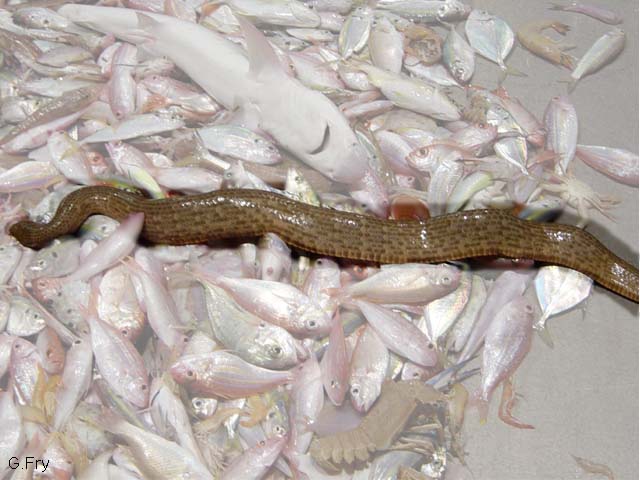| Hydrophiidae () |
| 200 cm TL (male/unsexed) |
|
reef-associated; marine; depth range 3 - 50 m |
| Indo-Pacific, Northwest Atlantic and the Mediterranean. Tropical and subtropical climates. |
|
Cephalic plates are large, relatively regular (not very fragmented) and symmetrical, with constant partial fragmentation in parietal region. Parietal plates often split in two. Small notches are sometimes visible on the forehead. There often or always seems to be a small median scale between frontal and prefrontal plates in new Caledonian populations. Eyes are separated from supralabials by a row of subocular scales, which are actually larger than the supralabials. Some anterior supralabials that are quite expanded dorso-ventrally can come in direct contact with the eyes. First pair of infralabials touches the posterior part of the mental plate. Midbody body scales (21 to 25 in a row) are smooth and overlapping - these scales have smaller diffuse blunted tubercles. Ventral scales (135 to 155 scales) are much wider than adjacent scales. They are slightly imbricate posteriorly with a median keel that is not always visible. Anal keel is divided, with a relatively prominent keel on each half (Ref. 2357, 2355). Has highly variable coloration and patterns. Adults are commonly solid grey to olive grey with small orangey-brown area in the anterior head region. Juveniles are greyish brown with fine ring-shaped vertical white undulated barring. Anterior orangey brown area is visible at birth. Body coloration turns from brown to predominantly grey and the rings gradually fade with age. Several creamy white or darkly spotted scales are scattered over the body. Brown body scales are often dark in the middle, giving rise to faint longitudinal streaks. Tail is brown or relatively pale and uniform in color (Ref. 2352). Fangs may be 0.7 cm long (Ref. 88063). |
| Maximum and common lengths also from Ref. 2352. Found along seabeds but prefers coral reefs and can rarely be observed in outer reef slopes (Ref. 2353). It is a generalist feeder, swallowing prey found near the seabed (Ref. 2360) and feeds on several species of reef fish in size range, 3 to 15 cm, including small snappers (Lutjanus lutjanus and Lutjanus kasmira), catfish (Plotosus lineatus), red-barred shrimp (possibly Stenopus hispidus). Especially active at night and tends to attack anything bright and moving. It is a relatively curious and unaggressive snake but can be dangerous (Ref. 2352). Females are larger than males and are potentially more dangerous because of higher venom yield (Ref. 2359). Preyed upon by tiger sharks (Galeocerdo cuvier). |
|
(LC); Date assessed: 30 May 2018 Ref. 123251)
|
|
|
Source and more info: www.sealifebase.org. For personal, classroom, and other internal use only. Not for publication.
Warning: Unknown: open(e:\temp\sess_pekduf3r02liah1ej0kuttfp61, O_RDWR) failed: Permission denied (13) in Unknown on line 0
Warning: Unknown: Failed to write session data (files). Please verify that the current setting of session.save_path is correct (e:\temp) in Unknown on line 0

